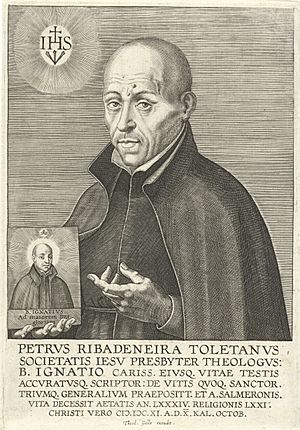Pedro de Ribadeneira facts for kids
Quick facts for kids
Pedro de Ribadeneira
|
|
|---|---|

Pedro de Ribadeneira (grabado de Theodoor Galle, 1610, Rijksmuseum, Ámsterdam).
|
|
| Born | Pedro Ortiz de Cisneros 1 November 1527, 1526 Toledo, Spain |
| Died | 22 September 1611 Madrid, Spain |
| Alma mater | |
| Occupation | Hagiographer, historian, writer |
Pedro de Ribadeneira was a Spanish priest and writer who lived a long time ago. He was born in Toledo, Spain on November 1, 1527, and passed away in Madrid on September 22, 1611. He was a member of a special religious group called the Society of Jesus (Jesuits). Pedro was also a companion of Ignatius of Loyola, who founded the Jesuits. He wrote many books, especially about the lives of saints.
Contents
Life Story of Pedro
Pedro was born in Toledo, Spain. His father was Alvaro Ortiz de Cisneros. Pedro's family had important connections. His great-grandfather was a governor of Toledo.
Early Years and Studies
When he was young, Pedro went to Italy. He worked as a page for a powerful church leader, Cardinal Alexander Farnese. In Rome, he met Ignatius of Loyola. On September 18, 1540, Pedro joined the Society of Jesus. This was just eight days before the Pope officially approved the group.
Pedro then went to study at several famous universities:
He studied subjects like philosophy and theology.
Teaching and Missions
In November 1549, Pedro was sent to Palermo. He taught rhetoric, which is the art of speaking and writing well. He worked at a new college opened by the Jesuits. For two and a half years, he taught there. In his free time, he visited sick people in hospitals.
Later, Ignatius of Loyola asked Pedro to help start the German College. This was a new school in Rome. In 1552, Pedro gave the opening speech for the college. Many important people, including church leaders, were there. He became a priest on December 8, 1553.
For the next 21 years, Pedro held many important jobs within the Jesuit order.
Travels and Later Life
In 1555, Loyola sent Pedro on a mission to Belgium. During this trip, he also visited England in 1558. This visit later inspired him to write a book. It was called Historia Ecclesiastica del scisma del Reyno de Inglaterra. This book was about the split of the Church in England.
Pedro traveled between Belgium and Rome. In 1558, he spent five months in London. He was called there because Mary Tudor, Queen of England, was very sick. She passed away during his visit.
In 1560, Pedro became the leader (Provincial) of the Jesuits in Tuscany. Then, in 1563, he became Provincial in Sicily. He also worked again in Flanders.
Later, a new leader of the Jesuits, Father Everard Mercurian, made a big change for Pedro. Pedro's health was not good. So, in 1571, he was told to go back to Spain. He went to his hometown, Toledo, to get better. This was hard for him, as he wanted to return to Italy. He kept asking to go back for several years.
Finally, in 1574, Pedro settled in Madrid. He lived there until he passed away on September 22, 1611.
His Important Books
Pedro de Ribadeneira wrote many books. His most famous work is the Life of Loyola. This book, published in 1572, was the first biography of Ignatius of Loyola. In his early versions of the book, Pedro said that Loyola had not performed any miracles. He believed Loyola's greatest miracle was founding the Jesuit Society.
Later, when Loyola was being considered for sainthood, Pedro changed his mind. In a book published in 1609, he said that miracles had happened. He explained that he knew about them in 1572 but wasn't sure they were proven then.
Another important work by Pedro was his Flos Sanctorum. This was a large collection of stories about the lives of saints. It was published between 1599 and 1610.
He also wrote:
- Tratado de la religion (1595): This book was meant to argue against the ideas of Niccolò Machiavelli's book, The Prince.
- Tratado de la tribulación (1589): This was his most famous book about spiritual struggles.
- Manual de oraciones para uso y aprovechamiento de la gente devota: A prayer book for religious people.
See also
 In Spanish: Pedro de Ribadeneira para niños
In Spanish: Pedro de Ribadeneira para niños

